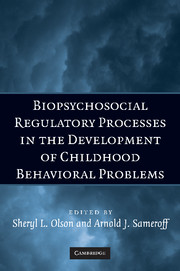Book contents
- Frontmatter
- Contents
- Preface
- Contributors
- 1 Conceptual Issues in Studying the Development of Self-Regulation
- 2 How Gene-Environment Interactions Can Influence the Development of Emotion Regulation in Rhesus Monkeys
- 3 Context Matters: Exploring Definitions of a Poorly Modulated Stress Response
- 4 An Integrative Approach to the Neurophysiology of Emotion Regulation: The Case of Social Withdrawal
- 5 Regulatory Competence and Early Disruptive Behavior Problems: The Role of Physiological Regulation
- 6 Behavior Regulation as a Product of Temperament and Environment
- 7 Self-Regulatory Processes in the Development of Disruptive Behavior Problems: The Preschool-to-School Transition
- 8 Emotional Dysregulation and the Development of Serious Misconduct
- 9 Regulatory Processes in Children's Coping with Exposure to Marital Conflict
- 10 Family Subsystems and Children's Self-Regulation
- 11 Culture and the Development of Regulatory Competence: Chinese–U.S. Comparisons
- 12 Self-Regulation and the Development of Behavioral and Emotional Problems: Toward an Integrative Conceptual and Translational Research Agenda
- Index
- References
9 - Regulatory Processes in Children's Coping with Exposure to Marital Conflict
Published online by Cambridge University Press: 02 July 2009
- Frontmatter
- Contents
- Preface
- Contributors
- 1 Conceptual Issues in Studying the Development of Self-Regulation
- 2 How Gene-Environment Interactions Can Influence the Development of Emotion Regulation in Rhesus Monkeys
- 3 Context Matters: Exploring Definitions of a Poorly Modulated Stress Response
- 4 An Integrative Approach to the Neurophysiology of Emotion Regulation: The Case of Social Withdrawal
- 5 Regulatory Competence and Early Disruptive Behavior Problems: The Role of Physiological Regulation
- 6 Behavior Regulation as a Product of Temperament and Environment
- 7 Self-Regulatory Processes in the Development of Disruptive Behavior Problems: The Preschool-to-School Transition
- 8 Emotional Dysregulation and the Development of Serious Misconduct
- 9 Regulatory Processes in Children's Coping with Exposure to Marital Conflict
- 10 Family Subsystems and Children's Self-Regulation
- 11 Culture and the Development of Regulatory Competence: Chinese–U.S. Comparisons
- 12 Self-Regulation and the Development of Behavioral and Emotional Problems: Toward an Integrative Conceptual and Translational Research Agenda
- Index
- References
Summary
Associations between predictors of family risk (e.g., interparental conflict) and children's emotional and behavioral dysregulation are well documented (Cummings & Davies, 1994; Emery, 1982; Grych & Fincham, 1990). A central aim of the developmental psychopathology framework is to articulate the processes underlying such associations and how these relations over time are related to the development of psychopathology (Cummings, Davies, & Campbell, 2000). Developmental psychopathology emphasizes process-oriented research concerned with identifying specific responses and patterns of behaviors underlying development, paying particular attention to how these responses and patterns change in different contexts over time. Working from a developmental psychopathology perspective, this chapter examines children's regulatory processes in response to exposure to different forms of marital conflict, as well as the relations of these regulatory responses to their broader adjustment. Specifically, this chapter integrates social (i.e., marital conflict) and regulatory (i.e., children's emotional and behavioral responses to marital conflict) processes to advance understanding of the relationships between children's regulatory expressions in these contexts and their overall adjustment.
INTERPARENTAL CONFLICT AS A FAMILY RISK FACTOR
Exposure to marital conflict is stressful for children (Emery, Fincham, & Cummings, 1992). Children exposed to angry adult interactions display increased arousal and dysregulated behavior (e.g., Cummings, Iannotti, & Zahn-Waxler, 1985; Cummings, Zahn-Waxler, & Radke-Yarrow, 1981). In this context, children report feelings of negative emotions, such as anger and fear (e.g., Goeke-Morey, Cummings, Harold, & Shelton, 2003).
- Type
- Chapter
- Information
- Biopsychosocial Regulatory Processes in the Development of Childhood Behavioral Problems , pp. 212 - 237Publisher: Cambridge University PressPrint publication year: 2009
References
- 3
- Cited by



